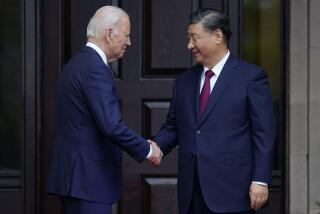U.S. Leaders Get to Know Who’s Hu
- Share via
WASHINGTON — Chinese Vice President Hu Jintao began a series of meetings Tuesday to get acquainted with top U.S. officials in anticipation of his selection as China’s leader.
Hu, 59, met with congressional leaders of both parties on Capitol Hill shortly after arriving in Washington. He also met one-on-one with Treasury Secretary Paul H. O’Neill and Commerce Secretary Don Evans before holding a working dinner with Secretary of State Colin L. Powell.
Today, Hu is scheduled to meet with President Bush at the White House. The men first met in February, when they shared a stage at Qinghua University in Beijing, where Bush delivered a speech.
Hu also will meet with Vice President Dick Cheney and will become the highest-ranking Chinese official to visit the Pentagon when he calls on Defense Secretary Donald H. Rumsfeld.
Largely unknown outside China, Hu is a relatively youthful figure among China’s aging leaders. He became a prominent player in 1992, during the rule of the late Deng Xiaoping.
Hu’s most notable job before becoming vice president was as head of the Communist Party in Tibet when martial law was declared in 1989 to put down unrest there.
American officials have been eager to size Hu up, and his visit to the United States amounts to something of a diplomatic coming-out party.
The status of Taiwan is a key issue in Sino-U.S. relations. China regards the island as a renegade province; the United States long has called for a peaceful resolution of the matter but has pledged to defend Taiwan, if necessary.
There is a growing sense in China that the United States has tilted too far in favor of Taiwan, said Minxin Pei, senior associate at the Carnegie Endowment for International Peace.
Relations between Washington and Beijing deteriorated in 1999 because of the accidental bombing of the Chinese Embassy in Belgrade, Yugoslavia, by U.S. warplanes during the Kosovo conflict. They worsened a year ago when a Chinese fighter jet collided with a U.S. reconnaissance plane off the Chinese coast, forcing the American plane and its crew to make an emergency landing on China’s Hainan island. After a tense standoff, China released the U.S. crew.
Bush has visited China twice since then and seemed to get along reasonably well with Chinese President Jiang Zemin. Jiang is scheduled to visit the United States in October.
On Capitol Hill, Hu received a cordial welcome Tuesday from the congressional leaders, who expressed a desire for better relations.
“Our message was: Let’s keep ... developing the relationship that we both want, both economically as well as diplomatically,” Senate Majority Leader Tom Daschle (D-S.D.) told reporters. “There’s a lot more we have in common than we have . . . in disagreement.”
Hu met with 16 senators for about an hour. One source present at the meeting said Hu also stressed that the two nations’ common interests outweigh their differences.
Congress passed a law in 2000 making normal trade relations between the United States and China permanent. But many lawmakers also strongly support Taiwan--as does Bush--and are harsh critics of China’s human rights record.
Some on Capitol Hill also have called for sanctions against China if it does not take steps to halt the proliferation of weapons of mass destruction.
On the House side, Minority Whip Nancy Pelosi (D-San Francisco), a frequent critic of China’s human rights record, said of Hu: “We have to give him a chance to see what he’s going to do. There’s nothing in his record that would give me reason to celebrate right now”--a reference to Hu’s service in Tibet.
Hu arrived in the United States on Saturday. In Honolulu, he toured Pearl Harbor and laid a wreath at the Arizona Memorial.
After stopping in San Francisco, he went on to New York, where he met with U.N. Secretary-General Kofi Annan and former Secretary of State Henry Kissinger.
Hu is scheduled to take over leadership of the Chinese Communist Party in the fall and to become president next spring.
Times staff writer Nick Anderson contributed to this report.
More to Read
Sign up for Essential California
The most important California stories and recommendations in your inbox every morning.
You may occasionally receive promotional content from the Los Angeles Times.













